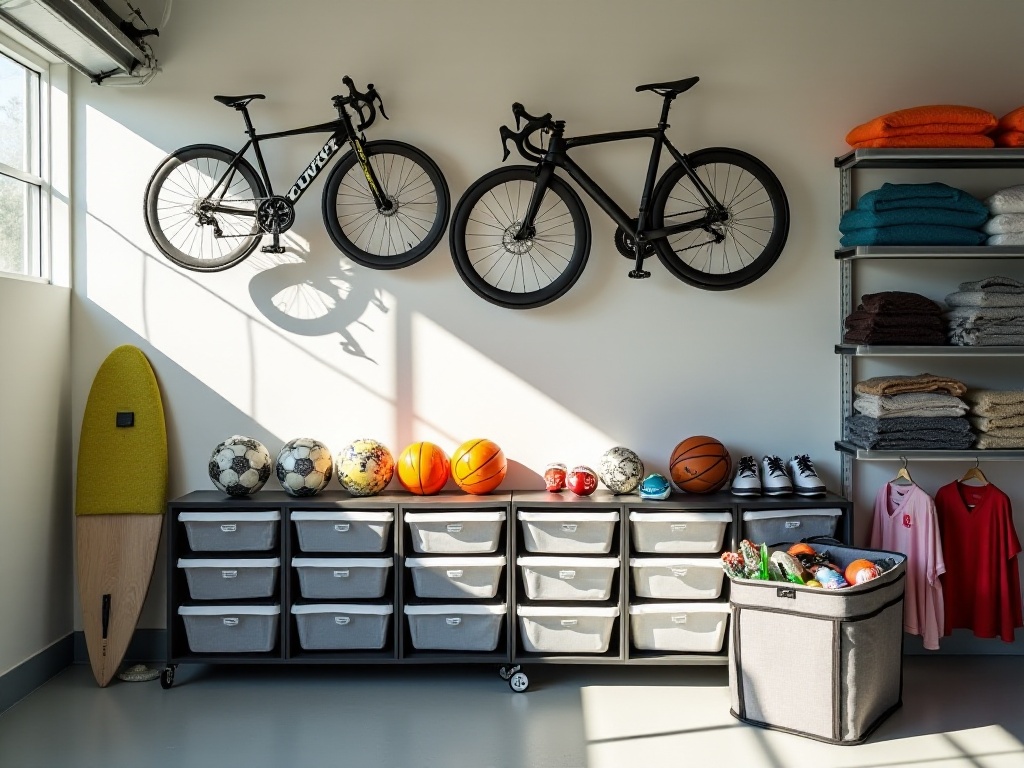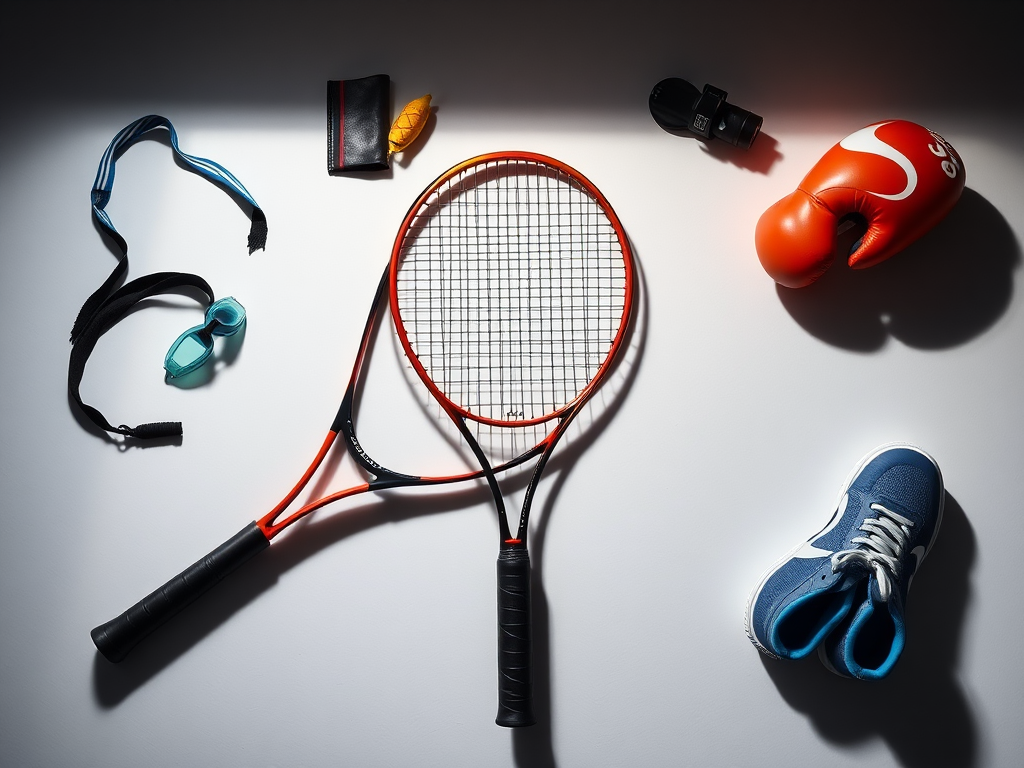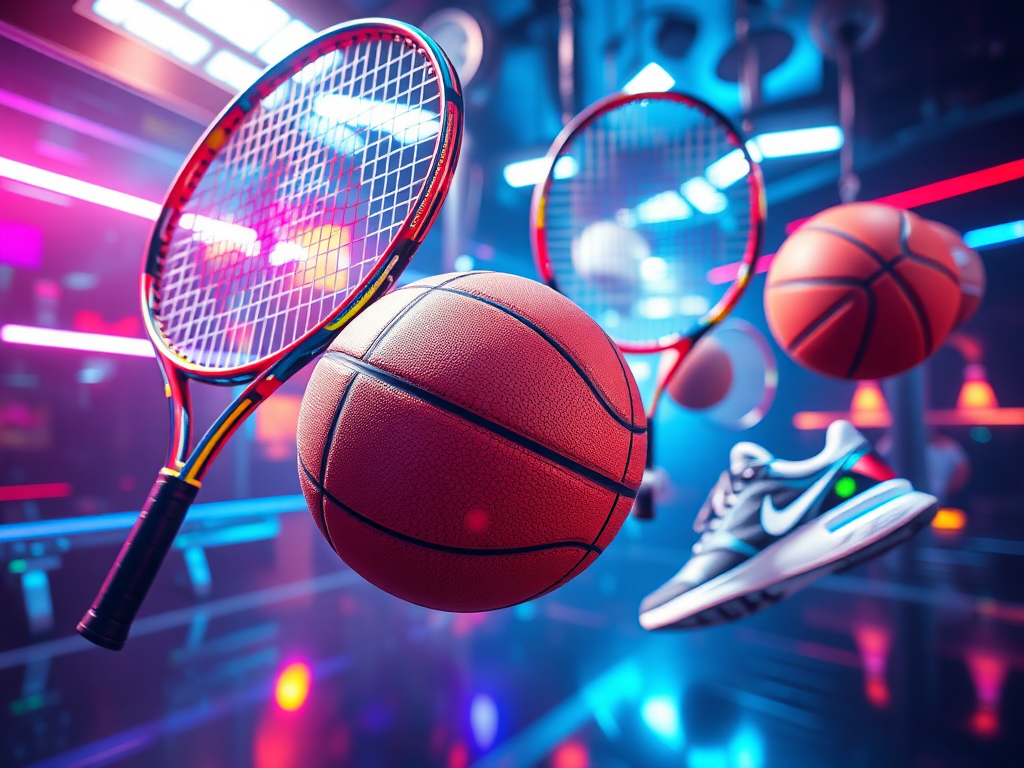Initial Thoughts
As a sports enthusiast, I've always been passionate about various types of physical activities. As my sports interests grew, sports equipment gradually piled up at home. Tennis rackets were often misplaced, soccer balls gathered dust in corners, and yoga mats were crumpled up in the depths of cabinets... These struggles are likely familiar to many sports enthusiasts.
I remember last summer when I invited friends over to play badminton, it took me half an hour to find the rackets, which were eventually discovered covered in dust in a corner of the storage room. At that moment, I finally decided to properly organize all this sports equipment. After more than a year of exploration and practice, I finally found a storage solution that works for me, and today I'd like to share my experiences.
Space Planning
Making the Most of the Garage
Honestly, bicycles are the most troublesome sports equipment when it comes to storage. A standard mountain bike takes up about 1 square meter of floor space, and with three or four bikes like in our home, the garage space gets filled up quickly. Last Chinese New Year, after adding two new bicycles, there was barely room to walk in the garage.
After extensive research and online investigation, I discovered a brilliant solution: transforming the garage wall into a storage wall. First, I installed several bike hooks with a 50kg weight capacity, made of reinforced steel for safety and reliability. Then, hanging the bikes vertically on the wall immediately freed up substantial floor space.
This renovation solution is not only practical but also aesthetically pleasing. I deliberately chose black hooks that, against the white wall, look like an art installation. After the initial transformation, the whole family was amazed. The formerly cluttered garage was transformed, and even dog-walking neighbors couldn't resist coming in to look around, asking about the renovation details.
Besides bikes, I also installed some small shelves on the garage walls for storing helmets, protective gear, and other cycling equipment. These shelves are secured with load-bearing screws, ensuring safety while maintaining easy access. Now when preparing for a ride, all equipment can be found at a glance, eliminating the need to search through everything.
Mobile Storage
As someone who frequently participates in various sports activities, I understand the importance of car storage. Previously, I would carelessly throw sports equipment into the trunk, making it very difficult to find things when needed. Once, I spent over ten minutes looking for a wristband before tennis, almost making me late.
After learning from this experience, I purchased a foldable multi-layer storage box. When unfolded, this storage box has three layers: the top layer for frequently used small equipment like tennis balls, protective gear, and sports towels; the middle layer for change of sports clothes and shoes; and the bottom layer for less frequently used larger equipment.
The storage box is made of waterproof nylon fabric, so there's no worry even if the equipment is slightly damp. Best of all, this storage box can be folded into a thin package when not in use, taking up minimal space. I specifically chose a model with wheels, making it easy to move even when full.
To better utilize car storage space, I also installed elastic mesh pouches on both sides of the trunk for temporary small items. Things like sports drinks and energy bars are easily accessible. In the corner of the trunk, I keep a waterproof storage bag specifically for potentially wet items, such as swimming gear or equipment used in rainy weather.
Categorized Storage
Drawer Organization
When it comes to storing sports clothing and accessories, this is a system I've refined through repeated experimentation. First, I designated two large drawers in the closet specifically for various sports clothes and accessories. Each drawer is divided into different sections using storage boxes, making it very convenient to find things.
In the first drawer, I organize training and competition wear by different sports. Basketball, soccer, and tennis clothes each have their own storage compartment. Each compartment is divided into upper and lower layers with dividers, with tops on the upper layer and bottoms on the lower layer. This classification method makes changing clothes very easy, and I no longer worry about finding matching sportswear.
The second drawer is dedicated to storing various protective gear and accessories. I use transparent storage boxes to separately store wristbands, knee pads, ankle guards, and other equipment. Each storage box is labeled for easy identification. Notably, I've provided each piece of protective gear with a breathable mesh bag, allowing ventilation even when damp after exercise, preventing mold.
In the corner of the drawer, I've specifically set up a "repair zone" for equipment that needs maintenance or repair. This includes things like sports shoes that need new laces or basketballs that need air. This setup allows me to identify and address equipment issues promptly, extending their lifespan.
Organization Principles
Before starting systematic storage, I recommend everyone do a thorough cleanup first. I remember being shocked by the amount of sports equipment accumulated in my home during my first cleanup. I found three basketballs alone, two of which were completely deflated. There were four tennis rackets, but only one was usable.
Through this cleanup, I developed the "Three No's Principle": dispose of unusable items promptly, streamline infrequently used items appropriately, and decisively transfer unsuitable items. This principle helped me clear out a lot of space and made storage more organized.
During the organization process, I found that many households face similar issues. According to relevant surveys, approximately 30% of sports equipment in average households is either idle or damaged. This idle equipment not only takes up space but also affects our mood when using other equipment.
After this major cleanup, I established a "regular inspection system." At the end of each quarter, I conduct a comprehensive inspection of all sports equipment. I check what needs maintenance, what needs replacement, and what can be given to others in need. This system allows me to identify and resolve issues promptly, maintaining neat and orderly storage space.
Equipment Classification
Ball Storage
Different types of balls require different storage methods, which is particularly important. Our family has experienced losses due to improper storage. For example, basketballs left randomly on the floor led to severe surface wear. Later, I bought a special ball storage rack that not only protects the balls but also saves space.
When choosing soccer balls, we need to pay special attention to ball sizes. Different age groups use different sized balls: children aged 5-8 are suitable for size 3 balls, which are lighter and appropriate for their strength level; children aged 8-12 should use size 4 balls, which are neither too heavy nor too light; those over 12 and adults can use standard size 5 balls.
Due to lack of knowledge about this, we bought a size 5 ball for my 10-year-old nephew, which was too difficult for him to kick, discouraging his interest in soccer. After switching to a size 4 ball, he immediately gained better control, and now he asks me to play soccer with him every week.
For tennis balls, I use a specialized tennis ball tube. This storage tube not only protects the balls' elasticity but also prevents them from rolling around. Plus, the tube is transparent, making it easy to see how many balls are left and when to replenish.
Badminton shuttlecocks also require special storage. I use a covered storage box with several desiccant packets to prevent the shuttlecocks from becoming damp and deformed. The storage box is divided into two layers, with new shuttlecocks on top and used training ones below, making usage very organized.

Protective Gear Storage
When it comes to storing protective equipment, this is absolutely crucial as it directly affects usage safety and lifespan. Statistics show that properly stored and maintained protective equipment can have its lifespan extended by over 40%. This data made me pay extra attention to storing protective equipment.
I hang all helmets on dedicated hooks, which allows for ventilation while preventing deformation. Protective gear is stored in breathable mesh storage bags, which prevent dust while maintaining air circulation. Each protective gear bag is labeled with the purchase date and recommended replacement time, enabling timely replacement of aged equipment.
For special protective equipment like taekwondo gear, I use a layered storage approach. Hand guards, foot guards, and headgear are stored in different compartments, making it easy to quickly find needed equipment. Moreover, these protective items are stored vertically, which not only saves space but also prevents creasing.
When storing protective equipment, I pay special attention to moisture prevention. I place several packets of activated charcoal in the corners of the storage cabinet to absorb moisture and odors. I also regularly air out the protective gear to maintain dryness. After use on rainy days, protective gear must be completely dry before storage to prevent mold.

Cleaning and Maintenance
Basic Cleaning
Speaking of cleaning, this is absolutely the most important aspect of equipment maintenance. Research shows that uncleaned sports equipment has 15 times more bacteria than normal object surfaces. This data is truly shocking and has made me pay more attention to equipment cleaning.
Now I've developed a good habit: after each workout, I wipe down equipment with mild cleaner. For ball equipment, I use special cleaning cloths that clean without damaging the ball surface. Sports clothes need to be dealt with immediately, not allowing sweat stains to remain on clothes for too long.
It's particularly important to note that different materials require different cleaning methods. For example, I gently wipe yoga mats with mild cleaner and let them air dry naturally. Treadmills need regular treatment with professional cleaner on the belt to ensure safe use.
Drying after cleaning is also important. I let equipment air dry in a ventilated area, avoiding direct sunlight. This is especially important for rubber products, which can age and deform if exposed to strong sunlight for long periods.

Professional Maintenance
Some special equipment requires more professional maintenance methods. For example, my ice skates need particular attention after each use. First, I wipe off moisture with a soft cloth, then oil the blades, and finally place them in special protective covers. This maintenance keeps the blades sharp and extends their lifespan.
Skateboards also need special care. After each use, I check if the bearings need cleaning and oiling, and if the wheels need replacement. If the deck shows wear, it needs to be addressed promptly to prevent cracking. These detailed maintenance tasks keep the skateboard in optimal condition.
For mechanical fitness equipment like treadmills, I regularly check if various components need oiling or adjustment. I check the belt monthly to ensure proper tension. While these maintenance tasks are tedious, they greatly extend the equipment's lifespan.
Lessons Learned
Through years of exploration and practice, I deeply understand that scientific storage not only keeps equipment in optimal condition but also makes our sports life easier and more enjoyable. Seeing well-organized sports equipment always inspires enthusiasm for exercise.
A reasonable storage system has revolutionized my sports life. Now when preparing for exercise, I no longer worry about finding equipment; after exercise, I can easily put all equipment back in place. This change not only saves time but also makes exercise more enjoyable.
Storage is not the end goal, but rather the beginning of making our sports life better. By establishing personalized storage systems, we can better enjoy the pleasure that sports bring. I hope these experiences can provide some inspiration to fellow sports enthusiasts.
Finally, I'm particularly interested in knowing how you store your sports equipment. Do you have any unique storage tips to share? Perhaps your experience will bring new inspiration to other sports enthusiasts. Let's create a better sports life together!







